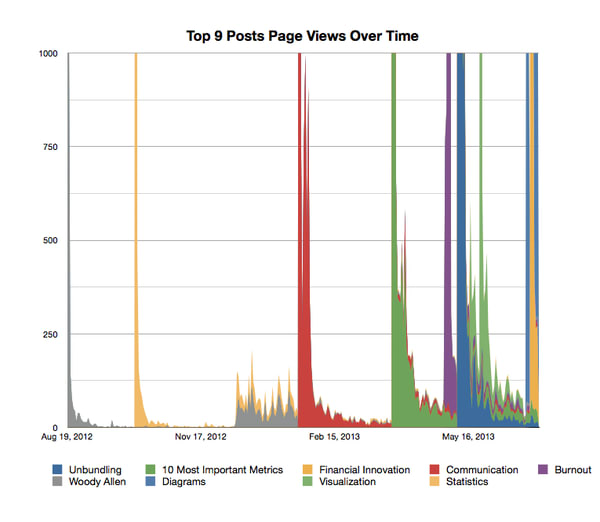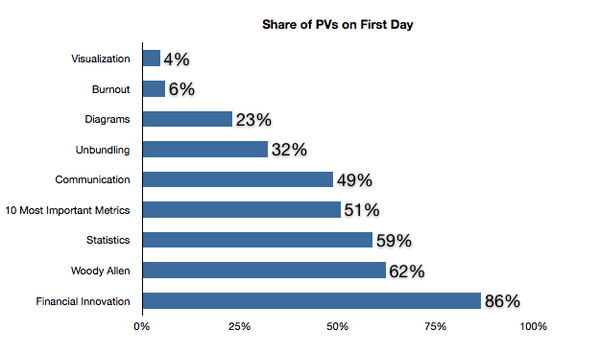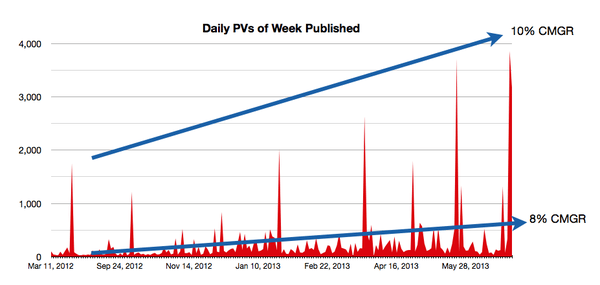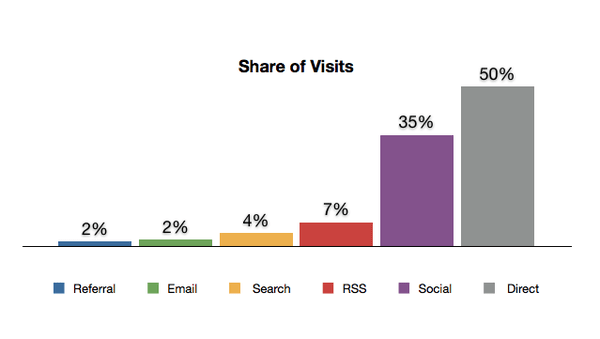3 minute read / Jul 2, 2013 /
The Compounding Returns of Content Marketing - The Data Behind Why Persistence Pays Off in Blogging
It is easy to write off content marketing as a waste of time. Effectiveness is difficult to measure; it is time consuming and the payback period on the investment is uncertain.
But unlike most forms of paid marketing, content marketing has a cumulative and compounding return. Each of the posts of a blog continues to attract traffic from SEO and social channels long after it has been published.
Below is a chart of the 9 most popular posts in the last 12 month on this blog. It is scaled to eliminate the peaks to better show how page views on these posts trend with time. There is a pattern of a huge spike on the first day of publication, followed by a tail of steady and consistent visits.
This data underscores the persistent, compounding benefits of content. The corollary is the larger a content base, the greater the traffic, because of the sum of the visitors to the older posts.
More interesting though, is the share of total page views of each post generated on the first day of publication. Across these nine posts, there is a huge range: 4 to 86%. The average is about 41%, meaning more than half of the page views on a top blog post occur one or more days after the post was published.
The net result for this blog has been a steady growth in visitors. I measure two different growth rates for the blog: the growth rate of the core readership and the growth rate of the spikes (when a post become interesting to a larger group).
Below is the daily page view count for this blog over the last 12 month. The core readership visits have grown by 8% each month. Meanwhile, the readership from spikes has grown by 10% each month.
Attributing the growth rate to any one particular driver is foolish. But I suspect the increasing size of the content library attracts readers, who may then subscribe via RSS or email, and then share the content on social networks.
The source traffic data do support this theory. Below is the chart depicting the share of visits by traffic source. More than half of all traffic is direct, RSS and email - the core readership. Social generates a bit more than a third, and it is clear that the social sharing reactivates interest in older content up to 10 times as frequently as search. This is why reblogging older posts, or content recycling, can be so effective in social media.
Maintaining a drumbeat of content creation requires discipline and persistence. But the compounding benefits of creating this library can drive sustained growth and awareness of your product, brand and company.
If you would like to perform this analysis on your content, I recommend using the Google Analytics developer tool found here. It provides API access to your Analytics account. To generate the data for the longitudinal analysis, type in ga:pagePath for the dimensions and ga:pageviews in the metric and output the data to Excel.



